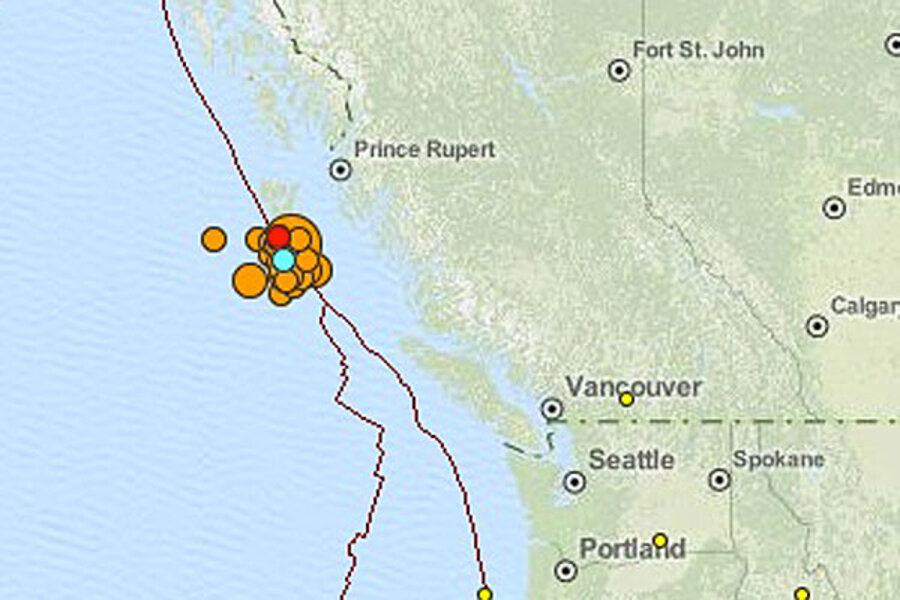Magnitude 7.7 earthquake rattles West coast of Canada
| Vancouver, British Columbia
A magnitude 7.7 earthquake struck off the west coast of Canada, but there were no reports of major damage. Residents in parts of British Columbia were evacuated but the province appeared to escape the biggest quake in Canada since 1949 largely unscathed.
The U.S. Geological Survey said the powerful quake hit the Queen Charlotte Islands just after 8 p.m. local time Saturday at a depth of about 3 miles (5 kilometers) and was centered 96 miles (155 kilometers) south of Masset, British Columbia. It was felt across a wide area in British Columbia, both on its Pacific islands and on the mainland.
"It looks like the damage and the risk are at a very low level," said Shirley Bond, British Columbia's minister responsible for emergency management said. "We're certainly grateful."
RELATED: Bizzare 2012 earthquake
The National Weather Service issued a tsunami warning for coastal areas of British Columbia, southern Alaska and Hawaii, but later downgraded the warning to an advisory for southern Alaska and British Columbia. Gerard Fryer, a senior geologist with the Pacific Tsunami Warning Center, said the first waves hitting shore in Hawaii are smaller than expected, but added it could be as long as seven hours before the warning is canceled if waves get bigger.
The weather service also issued an advisory for areas of northern California and southern Oregon.
Dennis Sinnott of the Canadian Institute of Ocean Science said a 69-centimeter (27 inch) wave was recorded off Langara Island on the northeast tip of Haida Gwaii, formerly called the Queen Charlotte Islands. The islands are home to about 5,000 people, many of them members of the Haida aboriginal group. Another 55 centimeter (21 inch) wave hit Winter Harbour on the northeast coast of Vancouver Island.
"It appears to be settling down," he said. "It does not mean we won't get another small wave coming through."
Canada's largest earthquake since 1700 was an 8.1 magnitude quake on August 22, 1949 off the coast of British Columbia, according to the Canadian government's Natural Resources website. It occurred on the Queen Charlotte Fault in what the department called Canada's equivalent of the San Andreas Fault — the boundary between the Pacific and North American plates that runs underwater along the west coast of the Haida Gwaii.
In 1970 a 7.4 magnitude quake struck south of the Haida Gwaii.
The USGS said the temblor shook the waters around British Columbia and was followed by a 5.8 magnitude aftershock after several minutes. Several other aftershocks were reported.
The quake struck 25 miles (40 kilometers) south of Sandspit, British Columbia, on the Haida Gwaii archipelago. People in coastal areas were advised to move to higher ground.
Urs Thomas, operator of the Golden Spruce hotel in Port Clements said there was no warning before everything began moving inside and outside the hotel. He said it lasted about three minutes.
"It was a pretty good shock," Thomas, 59, said. "I looked at my boat outside. It was rocking. Everything was moving. My truck was moving."
After the initial jolt, Thomas began to check the hotel.
"The fixtures and everything were still swinging," he said. "I had some picture frames coming down."
Lenore Lawrence, a resident of Queen Charlotte City on the Haida Gwaii, said the quake was "definitely scary," adding she wondered if "this could be the big one." She said the shaking lasted more than a minute. While several things fell off her mantle and broke, she said damage in her home was minimal.
Many on the B.C. mainland said the same.
"I was sitting at my desk on my computer and everything just started to move. It was maybe 20 seconds," said Joan Girbav, manager of Pacific Inn in Prince Rupert, British Columbia. "It's very scary. I've lived here all my life and I've never felt that."
Residents rushed out of their homes in Tofino, British Columbia on Vancouver Island when the tsunami sirens sounded, but they were allowed to return about two hours after the quake.
RELATED: Bizzare 2012 earthquake
_____
Associated Press writers Mark Thiessen in Alaska and Rob Gillies in Toronto contributed to this report.
Copyright 2012 The Associated Press.





